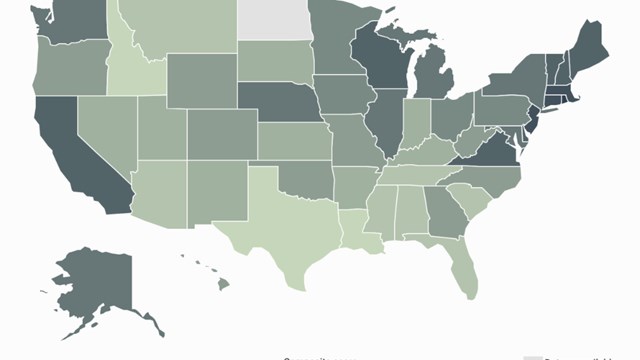Part of the appeal of living in a suburban HOA or condo association is living in an orderly and well kept community, with neighbors agreeing to uphold certain aesthetic standards for their properties to better preserve value for all.
What most unit owners desire for the exterior and common areas of their building or association is a clean, uniform look that helps preserve the value of both their own unit and other units in the community. After all, aesthetic standards can have a significant impact on property values in condo and co-op communities. Well maintained communities with consistent aesthetics tend to attract more buyers and command higher resale values than those with no standards or poorly enforced ones.
That’s why communities adopt aesthetic standards that spell out what needs to be done, what’s not allowed, and what happens if the standards aren’t upheld. To that end, most governing documents in co-ops, condos, and HOAs spell out an array of do’s and don’ts for residents’ yards, windows, and other public-facing elements of their units.
Setting the Rules
Michelle Quinn, a partner at the law firm of Gallet Dreyer & Berkey, works with co-op and condo boards in the Tri-State area on all manner of issues, including authoring and advising on rule enforcement issues. She notes that in a condominium or HOA, the governing documents consist of the declaration, the bylaws, and the house rules (in contrast to a cooperative, which also has a proprietary lease), which are where the standards of conduct for residents are set forth, including aesthetic and maintenance standards.
“The day-to-day and general unit owner guidelines are predominantly in the house rules, which can be easily modified by the board of managers,” she says. “There may be a different procedure for adopting HOA rules, which is usually spelled out in the bylaws.”
According to Min Hwan Ahn, an attorney who works with condos and HOAs in New Jersey, New York, and Philadelphia, a fair and enforceable aesthetic standard is one that strikes a balance between maintaining a cohesive appearance throughout the community and allowing individual residents some freedom to personalize their living spaces.
“Standards should be clear, reasonable, and uniformly applied to all residents,” he says. “For example, specifying acceptable exterior paint colors or requiring window treatments that conform to a certain style can be considered fair. Ultimately, aesthetic standards should balance the community’s interests in maintaining an attractive environment with individual owners’ rights to express themselves through their property.”
The Do’s & Don’ts
Windows and unit entry doors are frequent sites for limits and parameters, though according to the pros, New Jersey HOA rules tend to be less stringent than those in New York City.
For example, condos, co-ops, and HOAs all generally prohibit placing doormats in front of unit doors, because it is not only unsightly to have a bunch of mismatched rugs along a common hallway, but it is also a tripping hazard—especially in the event of a fire or other evacuation emergency.
“With the exception of religious symbols like a mezuzah, or in some buildings, holiday wreaths, associations also generally entirely prohibit hanging anything on the exterior of the entrance door of the unit,” for the same aesthetic reason that rugs and welcome mats are banned, Quinn says.
“Similarly,” she continues, “decorations or lights should not be affixed to exterior street- or outward-facing windows.” Quinn recounts a case more than a decade ago where a unit owner celebrated a holiday nearly every month of the year by placing a different holiday-themed entrance mat and wreath on his unit door, and covered his exterior window with holiday-themed decals, like stickers of eggs and bunnies at Easter, witches and ghosts at Halloween, and so on.
While the resident was certainly well meaning and the decorations didn’t pose an imminent hazard, “the ‘colorful’ look dissuaded prospective purchasers from buying,” she says. “Such decorations may be festive to some, but the unit owner was compelled to stop after the association brought an injunction action for violation of its house rules.”
When it comes to holiday displays, many boards set limits on the size, number, and number of days displays can be up, and may also require lights to be on timers set to shut off at a certain hour. Most rules prohibit more disruptive or distracting elements like strobes or music, and include practical standards for safety, like properly anchoring free-standing decorations and using the correct type of electrical connection.
When it comes to more everyday exterior additions, such as antennas or satellite dishes, Quinn says HOAs can’t prohibit them, but can restrict their size and location.
Over the Top?
Despite the importance of setting and enforcing aesthetic standards in a shared community, there are limits. A good rule is one that makes sense and is fair and justifiable; a poorly conceived rule is one that’s petty, unnecessary, or just plain over the top. It might help to consider how obvious a deviation from an aesthetic rule is in order to determine if it’s worth implementing and enforcing.
Quinn notes that examples of aesthetic overreach she’s seen in HOAs include things like dictating the exact distance a mailbox can be from the curb, the maximum height of the grass on residents’ lawns, or the line of sight of backyard items like swing sets, trampolines, or clothes lines from the street.
Some restrictions and requirements could be argued either way, says Quinn, depending on one’s own perspective and priorities. One example of ‘borderline restrictions’ “are paint color limitations for the exterior of the home,” she says. “There can be some flexibility within an approved color palette without sacrificing the overall quasi-uniform look. Even if the main paint color is more subdued, trim colors can be more lenient.”
An example of a fair and reasonable aesthetic standard would be requiring that all homes in the association be painted in earth-tone colors, while an unreasonable standard would require every home in the association to be painted in Sherwin Williams Universal Khaki. Another example could be a reasonable restriction on the size and placement of political signs during an election season, versus a complete ban on any political expression.
When Violations Happen
Generally speaking, a community’s house rules are the place where the board not only sets forth the community’s aesthetic standards, but also the consequences for violating them, which typically include fines, revocation of privileges, and other penalties.
When a resident runs afoul of his or her community’s aesthetic guidelines, the first step to correcting the issue is an initial warning letter from the board or management. If the resident disregards the warning, the board may escalate to fining the resident; in extreme cases, the association’s legal counsel may get involved.
Quinn notes that both the board’s right to fine rule breakers and the amounts of fines for specific infractions should be spelled out in a community’s house rules. The board should also retain its discretion to change the amount of a fine depending upon the seriousness of the default, its impact on other residents, and whether the conduct was blatantly intentional.
“If the fines go unpaid, they can either remain on the unit owner’s account until the unit is sold, at which time the account balance must be satisfied, or the condominium association can bring a civil court action for a money judgment,” says Quinn. “If there are unpaid common charges in addition to the fines, a common charge lien can be filed against the unit which, if the amount is great enough, can be foreclosed upon, though any bank holding a mortgage on the unit would be paid first.”
For the vast majority of violations, starting a lawsuit is usually the last resort—not only because it gets costly very quickly, but also because litigation causes so much acrimony and bad blood in a community.
“The condominium association or HOA’s general counsel should be made aware of any situation that is escalating so that proper documentation is issued and maintained for later use, including any photographs or videos,” says Quinn. “But before a board decides to pursue litigation, the owner should be invited to a board meeting to explain their side of the repeated behavior—which could result in a resolution without ever resorting to the courts.”
Ahn says that to effectively and fairly enforce aesthetic standards, boards and managers must first clearly establish what those standards are and give residents equally clear guidelines for what is acceptable and what isn’t.
“Communication is key,” he says. “Make sure all residents are aware of the rules by providing written copies of the guidelines upon move-in, and periodically as updates occur. Enforcement should be consistent, with violations addressed promptly and fairly.”
He adds that in cases where disputes arise regarding aesthetic standards, it’s crucial for boards and managers to work closely with legal counsel to ensure compliance with local laws and regulations while protecting the interests of both the community as a whole and individual residents.
Freedom of Expression
When buying into a condominium association or HOA, purchasers are aware of and subject themselves to the restrictions and standards that are imposed by the association. The protections of the First Amendment do not extend to contractual matters between two private parties—e.g., a community association and a member—though the restrictions imposed cannot be discriminatory.
According to Quinn, “The association can restrict displays of religious symbols, provided the rule does not expressly favor or disfavor any religion, and provided the rule does not have an underlying intent to discriminate or have a disparate impact on a specific religious group, which would amount to discrimination.”
Fundamentally, aesthetic rules are like any others that help govern a multifamily community and keep it running smoothly for the benefit of all who call it home. They should be specific without being needlessly restrictive; they should be clearly articulated and communicated to residents, and, says Quinn, “care should be taken that whatever the rules are, they are applied and enforced uniformly, with no selective treatment.”
Keith Loria is a freelance writer and contributor to CooperatorNews.










Leave a Comment